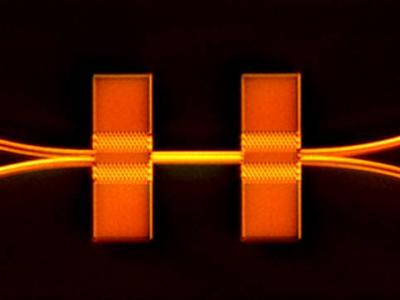The team previously discovered an 'attractive' force of light and showed how it could be manipulated tiny switches in semiconducting micro- and nano-electrical systems. They say they have now uncovered its non-evil twin - a repulsive force.
Researchers have theorized the existence of both the attractive and repulsive forces since 2005, but the latter remained unproven. The team, led by Hong Tang, assistant professor at Yale's School of Engineering&Applied Science, reported its findings in Nature Photonics.

Interacting lightwaves can be used to control devices on a silicon chip. Credit: Hong Tang/Yale University
"This completes the picture," Tang said. "We've shown that this is indeed a bipolar light force with both an attractive and repulsive component."
The attractive and repulsive light forces Tang's team discovered are separate from the force created by light's radiation pressure, which pushes against an object as light shines on it. Instead, they push out or pull in sideways from the direction the light travels.
Previously, the engineers used the attractive force they discovered to move components on the silicon chip in one direction, such as pulling on a nanoscale switch to open it, but were unable to push it in the opposite direction.
Using both forces means they can now have complete control and can manipulate components in both directions. "We've demonstrated that these are tunable forces we can engineer," Tang said.
In order to create the repulsive force, or the "push," on a silicon chip, the team split a beam of infrared light into two separate beams and forced each one to travel a different length of silicon nanowire, called a waveguide. As a result, the two light beams became out of phase with one another, creating a repulsive force with an intensity that can be controlled—the more out of phase the two light beams, the stronger the force.
"We can control how the light beams interact," said Mo Li, a postdoctoral associate in electrical engineering at Yale and lead author of the paper. "This is not possible in free space—it is only possible when light is confined in the nanoscale waveguides that are placed so close to each other on the chip."
"The light force is intriguing because it works in the opposite way as charged objects," said Wolfram Pernice, another postdoctoral fellow in Tang's group. "Opposite charges attract each other, whereas out-of-phase light beams repel each other in this case."
These light forces may one day control telecommunications devices that would require far less power but would be much faster than today's conventional counterparts, Tang said. An added benefit of using light rather than electricity is that it can be routed through a circuit with almost no interference in signal, and it eliminates the need to lay down large numbers of electrical wires.
Funding for the project includes a seed grant from the U.S. Defense Advanced Research Projects Agency and a Young Faculty Award from the National Science Foundation.
Citation: DOI: 10.1038/NPHOTON.2009.116





Comments